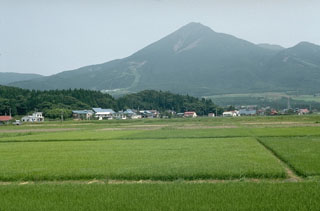Report on Bandaisan (Japan) — August 2000
Bulletin of the Global Volcanism Network, vol. 25, no. 8 (August 2000)
Managing Editor: Richard Wunderman.
Bandaisan (Japan) Unprecedented increase in seismicity during 14-16 August
Please cite this report as:
Global Volcanism Program, 2000. Report on Bandaisan (Japan) (Wunderman, R., ed.). Bulletin of the Global Volcanism Network, 25:8. Smithsonian Institution. https://doi.org/10.5479/si.GVP.BGVN200008-283160
Bandaisan
Japan
37.601°N, 140.072°E; summit elev. 1816 m
All times are local (unless otherwise noted)
The last increase in seismicity at Bandai (located in the Fukushima prefecture about 20 km N of Tokyo) occurred in November 1988 (SEAN 13:11) when a total of 188 seismic events was recorded, up sharply from the background level of ~20 events/month. In contrast, at the same site up to 416 seismic events were recorded in one day when seismicity increased during 14-16 August 2000.
On the afternoon of 16 August the Japanese Meteorological Agency (JMA) issued a volcano advisory for Bandai. An abnormally high number of earthquakes, including felt earthquakes and volcanic tremor, was recorded at the A site seismometer 1.8 km SSE of the summit. The increase began on 14 August when 179 seismic events were recorded; this was the greatest seismicity to occur at the volcano since seismic monitoring began in 1965. On 14 August two of the four M 2 earthquakes that occurred were felt, and a volcanic tremor event lasted for 31 seconds. On 15 August the level of seismicity increased to 416 events, and two volcanic-tremor events lasted 40 and 55 seconds, respectively. At 2304 on 15 August a M 2.9 earthquake occurred, which was the largest event in the series. As of 1400 on 16 August there were 41 events. On 18 August a climbing ban was placed on the volcano. Due to the abnormally high level of seismicity, scientists monitored closely for signs of an impending eruption. Scientists observed no large change in GPS data or images from the monitoring camera. On 28 September officials lifted the climbing ban but warned climbers that an eruption could still occur.
Geological Summary. One of Japan's most noted volcanoes, Bandaisan rises above the north shore of Lake Inawashiro. This complex is formed of several overlapping andesitic stratovolcanoes, the largest of which is Obandai. Kobandaisan peak, which collapsed in 1888, was formed about 50,000 years ago. Obandai was constructed about 40,000 years ago after a Plinian eruption resulted in the collapse of an older edifice and the Okinajima debris avalanche to the SW. The last magmatic eruption took place more than 25,000 years ago, but four major phreatic eruptions have occurred during the past 5,000 years, most recently in 806 and 1888 CE. Seen from the south, Bandaisan presents a conical profile, but much of the north side of the volcano is missing as a result of the collapse of Kobandaisan during the 1888 eruption, causing a debris avalanche that buried several villages and formed several large lakes.
Information Contacts: Volcano Research Center - Earthquake Research Institute (VRC-ERI), University of Tokyo, Yayoi 1-1-1, Bunkyo-ku, Tokyo, 113-0032 Japan (URL: http://www.eri.u-tokyo.ac.jp/VRC/index_E.html); Maki Kazuo, JMA-Sendai, 1-3-4 Ote-machi, Chiyoda-ku, Tokyo 100, Japan; The Japan Times.

